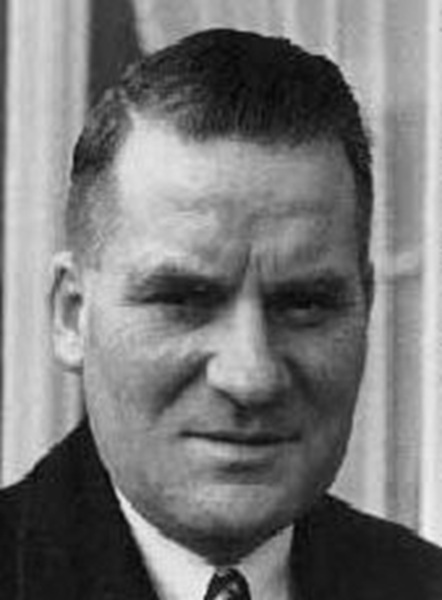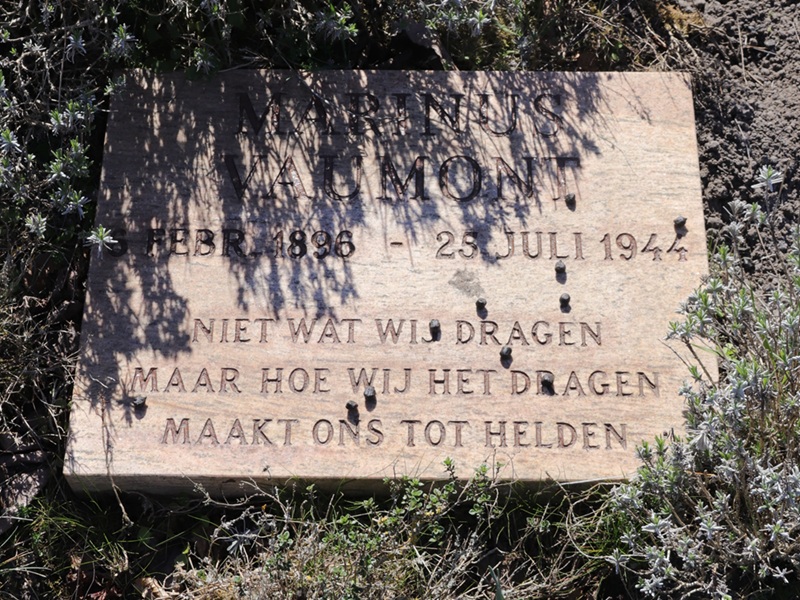Vaumont, Marinus
- Date of birth:
- February 6th, 1896 (Haarlem/North Holland, Netherlands)
- Date of death:
- July 25th, 1944 (Haarlem/North Holland, Netherlands)
- Buried on:
- Dutch Honorary Cemetery Bloemendaal
Plot: 40. - Nationality:
- Dutch
Biography
Lived in Heemstede, Bachlaan 17. Vaumont originally bore the first names Marinus Petrus Marie. By decision of the subdistrict court for the Leeward Islands in Curaçao dated 18 October 1937, permission was granted to change this to Marinus. Son of typesetter Paulus Wilhelmus Marinus Vaumont (31 October 1860 Haarlem – 18 April 1934 Haarlem) and Johanna Monné (13 June 1861 Haarlem – 12 November 1944 Haarlem). Married Cornelia Groes (2 January 1900 Haarlem) on 15 May 1918. Cook/hotelier on Curaçao/after returning to the Netherlands, a gentleman of independent means. No church. Member of the resistance. He used the aliases Jan van Heemstede and Schotborg. Vaumont was active in many areas of the resistance. He took care of approximately five hundred seamen's wives and their children, first under the banner of the Zeemanspot and later under that of the Nationaal Steunfonds (NSF). He also provided (Jewish) people in hiding with money and ration cards. In 1943 he went on to lead the LO in Heemstede. He was also a co-initiator of the KP in Heemstede. The robbery of the local police station carried out under his leadership was his undoing. The so-called ‘exchange police’ of the Regional Labour Office had delivered five student-hiders ‘for safekeeping’, as it says in a court report, at the police station. The robbery was intended to free them. A member of the resistance group, Miss W. de Voogt, was allowed by the watch commander W. Uittenbogaard to enter the station to talk to the ‘boys’ for a moment. She wanted to inform them about the upcoming robbery, but her plan failed because the arrestees were being aired out in the air cell by officer Joh. Kamping at that very moment. After that, her colleague Ben Lenderink managed to enter the police station. He pressed his revolver into Kamping's back and freed the five prisoners. The police officer himself disappeared into the cell. Vaumont remained at the police station during the robbery. He drew attention to himself by cycling a short distance behind one of the fugitives and giving him an address to go to. He then returned to the police station to try to throw the police officers off the trail. ‘I know where they have fled to,’ he said. Uittenbogaard realised that he was involved in the liberation operation. The police officer, who had managed to catch two people in hiding, thought that he was obstructing the search for the escaped men. The guard commander ordered his colleague to arrest him. When the officer made a move towards his inside pocket, sergeant Johannes Kamping searched him and a revolver was found. The police officer made him walk in front of him. When he thought he saw a chance to escape and took off, he fired at the man from Heemstede. The ‘hyper-nervous’ police officer, according to one of the court reports, even emptied his entire weapon. Vaumont was seriously injured and transferred to the Diaconessenhuis in Haarlem, where he succumbed to his injuries at the end of the afternoon. In 1946, the two police officers, who were known to be good Dutchmen, had to answer for their actions before the Special Court in Amsterdam. Prosecuting attorney J. Besier, LL.M., demanded a five-year prison sentence for the police commander and three years for the officer. Two weeks later, the court sentenced Uittenbogaard to five months in prison and Kamping to three months. These sentences were equal to the time spent in pre-trial detention. Both police officers were so relieved about the favourable outcome of the criminal case that they threw their hats up to the ceiling in the hallway of the Special Court. A memorial stone has been placed on the façade of the building at 17 Havenstraat on the corner of Jacob van Campenstraat with the following text: ‘Here Marinus Vaumont fell on 25 July 1944 during a raid to free imprisoned fellow countrymen.’ In Heemstede, the Vaumontlaan is named after him. His name is on a plaque on the Statue of Liberty in Heemstede. He was posthumously awarded the Resistance Cross.
Do you have more information about this person? Inform us!
- Period:
- Second World War (1939-1945)
Sources
- Photo 1: Eerebegraafplaats Bloemendaal
- Photo 2: Arjo Eijgelsheim
- De beschrijving van de voor Vaumont fataal verlopen bevrijding van de ondergedoken studenten berust op rechtbankverslagen in het Nieuwsblad van het Zuiden (13 november 1946) en De Waarheid (12 november 1946) en berichten over de vonniswijzing in beide bladen op 27 november 1946, respectievelijk 26 november 1946; Peter H. Heere en Arnold Th. Vernooij, De Eerebegraafplaats te Bloemendaal, SDU Uitgevers, Den Haag, 2005; Marcel Bulte en Hans Krol, Heemstede 1940-1945. Een gemeente in bezettingstijd, Vereniging Oud-Heemstede Bennebroek, De Vrieseborch, Haarlem, 1995; W.A. Brug, Hun naam leeft voort...! Oorlogsslachtoffers verleenden hun naam aan straten en gebouwen, Repro Holland BV, Alphen aan den Rijn, 1989; LO/LKP, Het Grote Gebod; Oorlogsgravenstichting; site wiewaswie.nl (waaronder overlijdensakten 179/1944 gemeente Heemstede en 1389/1944 gemeente Haarlem); site 4en5mei.nl.
- Eerebegraafplaats Bloemendaal




